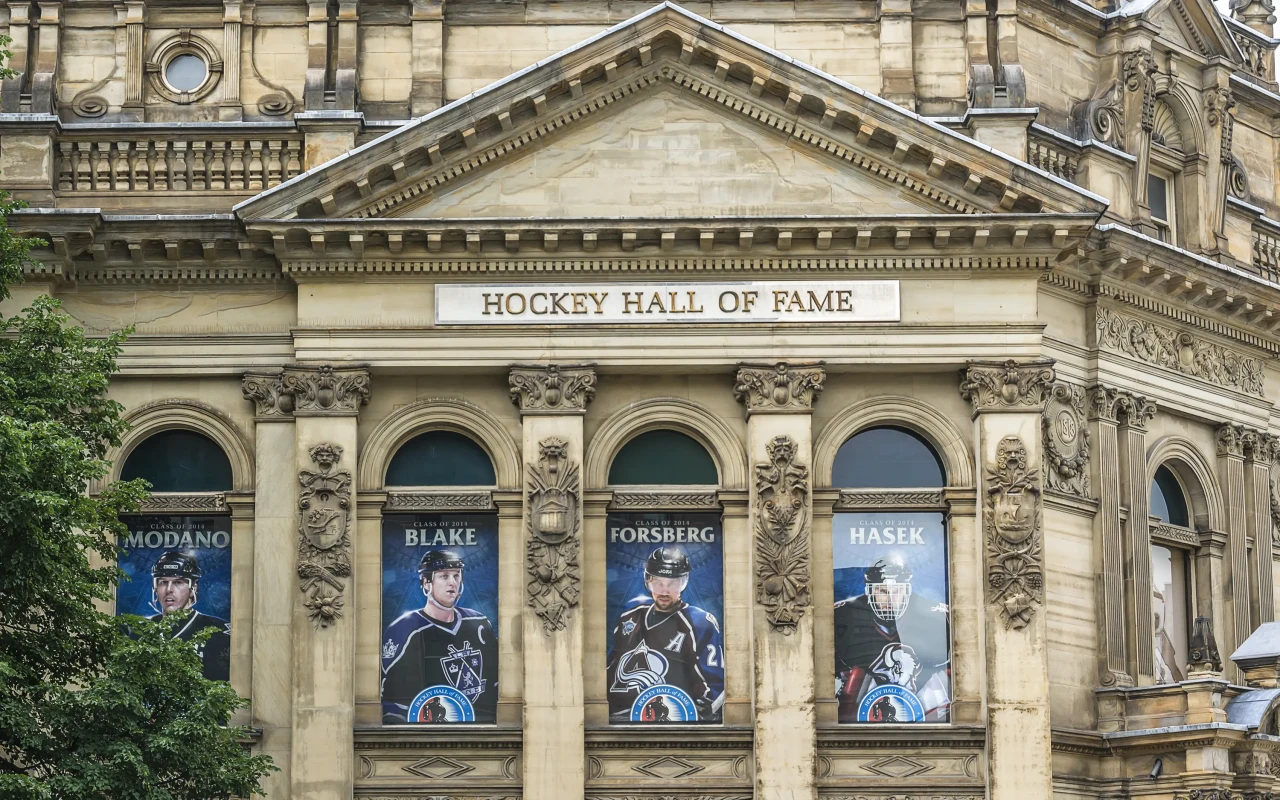Claim to Fame
The Hockey Hall of Fame is the ultimate shrine to the sport — home to the Stanley Cup and the most iconic collection of hockey memorabilia in the world.
📌 Navigating Hockey Hall of Fame : Answers to Frequently Asked Questions
- Admission Fee: Admission fees apply, with various ticket options available, including discounts for students, seniors, and children.
- How Long to Visit: Visitors typically spend 2-3 hours exploring the exhibits, interactive games, and the Stanley Cup display.
- Washrooms: Accessible washroom facilities are available for visitors.
- Hours of Operation: Hours of operation vary, typically from 10:00 am to 5:00 pm, but it's recommended to check the official website for current hours and special holiday schedules.
- Important Information: The Hockey Hall of Fame is a must-visit for hockey enthusiasts, offering a deep dive into the history of the sport, its legends, and the iconic Stanley Cup.
- Restaurant or Cafe: There is a cafe inside the Hockey Hall of Fame, and being in downtown Toronto, there are numerous dining options nearby.
- Gift Shop: The gift shop offers a wide range of hockey-related merchandise, including apparel, equipment, and memorabilia.
- Handicap Accessible: The Hockey Hall of Fame is accessible to visitors with disabilities, featuring ramps, elevators, and accessible restrooms.
- Pets: Pets are not allowed inside the Hockey Hall of Fame, except for service animals.
- Guided Tours: Guided tours are not typically offered, but visitors can explore the exhibits at their own pace, and staff are available for questions and assistance.
- Picnic Area: No designated picnic areas are available within the Hockey Hall of Fame. Visitors are encouraged to dine at the cafe or explore nearby restaurants.
- Parking: Parking is available at nearby public parking lots, but it can be limited during peak times. Public transportation is a convenient option due to its central location in downtown Toronto.
- Family Friendly: The venue is family-friendly, offering interactive exhibits and activities that appeal to hockey fans of all ages.
- Photography: Photography is allowed for personal use within the Hockey Hall of Fame, but flash photography and tripods may be restricted.
- WIFI: Free WIFI is available for visitors within the Hockey Hall of Fame.
Photos of Hockey Hall of Fame
Located in downtown Toronto, the Hockey Hall of Fame is a bucket-list destination for any fan of the game. Whether you're a lifelong follower of the NHL or just curious about the cultural impact of hockey, this interactive museum combines history, legends, and cutting-edge exhibits in a setting that celebrates the spirit of the sport.
Housed in a stunning Beaux-Arts building that once served as a bank, the Hall is more than just a museum — it’s a temple to the game’s greatest players, coaches, and contributors from around the globe.
What to Expect
Inside, you'll find an immersive experience that covers all aspects of the game. Highlights include the Esso Great Hall, where inductees are honored and the actual Stanley Cup is displayed. Interactive areas let you test your goaltending reflexes or take shots on a virtual goalie. Exhibits explore international hockey, women’s leagues, and iconic moments in history.
The museum is surprisingly large and packed with engaging content for all ages, including rare footage, personal gear worn by legends, and a replica NHL dressing room.
Background and Cultural Context
Founded in 1943, the Hockey Hall of Fame was originally located in Kingston, Ontario, before moving to its current home in Toronto in 1993. It’s recognized globally as the definitive institution for honoring excellence in the sport, covering all leagues and levels — from the NHL to international competition, including Olympic and women's hockey.
The Hall plays a central role in maintaining the historical record of the sport and ensuring the achievements of hockey’s finest are celebrated for generations to come.
Best Time to Visit
Weekday mornings tend to be the least crowded, allowing more time and space to explore the exhibits. If you're in Toronto during hockey season (October through April), the Hall offers a great pre-game stop before a Maple Leafs match at nearby Scotiabank Arena.
How to Get There
The Hall is located at the corner of Front and Yonge Streets in the Brookfield Place complex. It’s easily accessible by TTC (King or Union Station), GO Transit, or a short walk from many downtown hotels. Underground PATH access makes it easy to reach in any weather.
Photo Opportunities
- Standing next to the Stanley Cup in the Great Hall
- Outside the historic facade of the original bank building
- Action shots in the interactive play zones
- Inductee plaques and displays of legendary jerseys and gear
Travel Tips
- Book tickets in advance during holidays or playoff season to avoid wait times.
- Allow at least 1.5 to 2 hours to explore comfortably.
- Check their rotating exhibit schedule — limited-time displays are often some of the most memorable.
FAQs
Can I touch the real Stanley Cup?
Yes! If it’s on-site (it sometimes travels), you can pose with and even touch the real Cup on display.
Is it kid-friendly?
Absolutely. The interactive exhibits are great for children and teens, especially the virtual goalie and shooter games.
Are there discounts?
Yes — family passes, student rates, and combo packages with other attractions are often available.
Final Thoughts
The Hockey Hall of Fame isn’t just for die-hard fans — it’s an inspiring celebration of perseverance, greatness, and the human spirit through the lens of one of the world’s most beloved sports. Whether you're Canadian or just curious, it's an unforgettable stop in the heart of Toronto.
